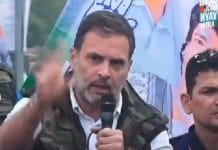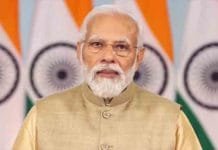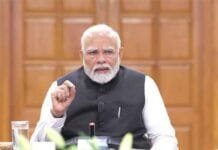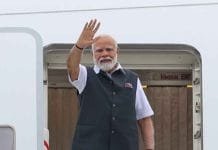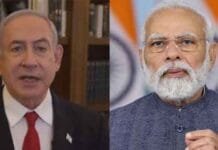INVC NEWS New Delhi — In the wake of the brutal Pahalgam terror attack, the Indian Army launched a precision offensive deep into Pakistan-occupied Kashmir (PoK) and across the Pakistan border, taking down over 100 militants in a swift operation named Operation Sindoor. This decisive military action marked a new era of India’s counter-terrorism policy — one driven by direct retaliation, global messaging, and strategic continuity.
But while the cross-border strikes dominated the headlines, Prime Minister Narendra Modi’s actions over the following 36 hours have sent an even louder message to Pakistan and the world: India is not done yet.
Operation Sindoor: A High-Stakes Night Offensive
At precisely 1:05 AM on Tuesday night, the Indian Army initiated Operation Sindoor, targeting nine strategic terror hideouts operated by Lashkar-e-Taiba and Jaish-e-Mohammed across Pakistan and PoK. Within just 25 minutes, India’s forces unleashed a wave of destruction, neutralizing over 100 terrorists and obliterating militant camps that had been festering for years.
The Indian Army described the strike as “surgical, swift, and silent,” leaving Pakistan’s establishment stunned and scrambling for answers. Explosions echoed across terror hideouts that had been shielded by ISI support, proving that no one is untouchable when India decides to act.
PM Modi’s Strategic Response: Beyond the Battlefield
Even before the dust settled across the Line of Control, Prime Minister Narendra Modi had already begun orchestrating India’s next moves. In the first few hours after the operation, PM Modi was closely monitoring live updates from the armed forces, receiving detailed reports from senior military commanders and the National Security Advisor (NSA) Ajit Doval.
High-Level Meeting with NSA Ajit Doval
Immediately following Operation Sindoor, the Prime Minister held an urgent meeting with NSA Doval, in which the two leaders reviewed the intelligence, discussed further threats, and outlined continuation plans for similar strikes if Pakistan escalated.
The message from the top leadership was clear — this was only the trailer, and India is prepared to unveil the full picture if provoked further.
CCS Meeting: Consolidating National Security Strategy
PM Modi followed up the NSA briefing with a meeting of the Cabinet Committee on Security (CCS), bringing together the top brass of Indian defense and political leadership. Present in the meeting were:
Home Minister Amit Shah
Defense Minister Rajnath Singh
Union Minister Nitin Gadkari
BJP President JP Nadda
Cabinet Minister Shivraj Singh Chouhan
In this critical session, the Prime Minister informed the cabinet about the operation’s success and discussed the next steps in India’s broader security policy. According to sources, all ministers expressed unwavering confidence in PM Modi’s leadership and praised the Indian Army’s flawless execution.
Addressing the Global Space Community with a Subtle Message
Despite the intensity of military operations, Prime Minister Modi maintained a balanced front on the international stage. On Wednesday morning, PM Modi addressed the Global Space Exploration Conference, emphasizing that India’s ambitions were peaceful but resolute.
“India’s space journey is not about competition — it is about cooperation,” he declared. “We will soon launch a special G-20 satellite, a gift to the Global South.”
This dual-track diplomacy sent a crystal-clear message: India can lead with both strength and science.
Cabinet Briefing: Building Internal Consensus
Later on Wednesday, PM Modi chaired a cabinet meeting, where he again briefed his ministers on Operation Sindoor, outlining the precise objectives, timing, and execution strategy of the mission.
Inside sources revealed that the Prime Minister praised the Army for its timely and accurate targeting and called the operation a “decisive message” to terrorism’s enablers. The cabinet ministers, across portfolios, stood in solidarity with the Prime Minister’s vision of zero tolerance toward cross-border terror.
Meeting with President Droupadi Murmu: Upholding Democratic Transparency
In a rare yet symbolic gesture, Prime Minister Modi met with President Droupadi Murmu on Wednesday afternoon. The meeting, which was officially photographed, signified transparency at the highest levels of democratic governance.
During the session, PM Modi personally informed the President of Operation Sindoor’s objectives and outcomes. The visuals of the Prime Minister and President together, in deep discussion, resonated across media platforms as a reminder of India’s institutional integrity in times of crisis.
Diplomatic and Strategic Fallout for Pakistan
In the backdrop of Operation Sindoor, India intensified its diplomatic offensive against Pakistan. In a firm response to the Pahalgam attack, PM Modi had earlier:
Cancelled the Indus Water Treaty, cutting off vital resources to Pakistan.
Severed diplomatic channels, halting bilateral talks and engagement.
Terminated trade relations, cutting Pakistan off from critical imports.
These decisions weren’t reactive—they were part of a long-term punitive policy, signaling that India is rewriting the rules of engagement.
Midway Cut in Saudi Tour: PM Modi Puts Nation First
In a display of unwavering national commitment, Prime Minister Modi cut short his official Saudi Arabia visit following the Pahalgam incident. Returning directly to New Delhi, PM Modi plunged into a series of high-level security briefings, working tirelessly through the night with military advisors and intelligence chiefs.
His return and active oversight of Operation Sindoor show a leader who places national security above diplomacy, a signal that resonated deeply with both global observers and Indian citizens.
Empowering the Armed Forces with a Free Hand
Perhaps one of the most defining decisions taken by PM Modi during this 36-hour span was to grant the Indian Army a free hand. This meant that operational command could act without bureaucratic delay, and the military’s strategic autonomy was fully restored.
With that green light, the Indian forces demonstrated the full extent of their readiness and lethal precision, destroying entrenched terror bases within minutes.
What Lies Ahead: The Full Picture Is Yet to Come
While Operation Sindoor may have ended within half an hour, its strategic implications will last far longer. PM Modi’s decisive leadership has set the tone for India’s new anti-terror doctrine — one that is assertive, unrelenting, and unafraid.
From military retaliation to diplomatic isolation, from economic disengagement to strategic messaging at global forums, India has activated all channels of pressure against Pakistan.
The Prime Minister’s 36 hours of relentless action reflect a new chapter in India’s counter-terrorism playbook. As PM Modi himself warned, the trailer has been shown, but the picture is yet to come — and if Pakistan continues its proxy war, India is ready to roll the full film.


